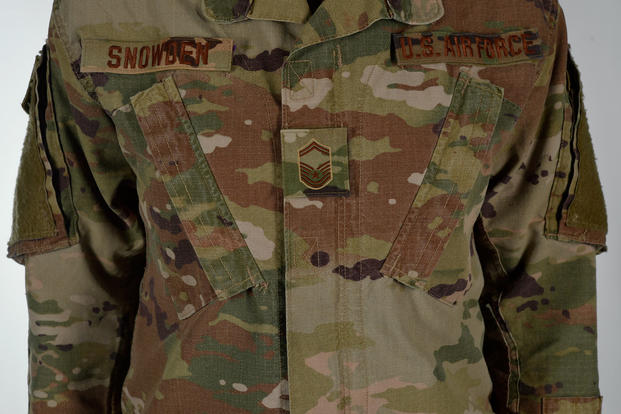The U.S. Air Force is on track to begin distributing its new Operational Camouflage Pattern combat uniform beginning Oct. 1.
Airmen who currently own and wear the uniform may start wearing it full-time on that date, a service spokeswoman said last week. This could apply to Air Force Special Operations Command units, for example, which currently wear the OCP pattern.
Meanwhile, airmen at Aviano Air Base, Italy; MacDill Air Force Base, Florida; and Shaw Air Force Base and Joint Base Charleston, South Carolina, will be the first to see the uniform on sale at base stores.
The service will phase out the Airman Battle Uniform, known as the ABU, for the OCP over the next three years, with the expectation that all airmen will be wearing the OCP by April 1, 2021.
The service updated Air Force Instruction 36-2903, "Dress and Personal Appearance of Air Force Personnel," in July to give airmen guidance on how to properly wear their OCPs.
Related content:
- Air Force Collecting Feedback to Design Better-Fitting Flight Suits
- It's Official: The Air Force Is Switching to the Army's OCP Uniform
- No Secret Message in New Uniform Announcement, Air Force Says
"OCPs purchased by Air Force personnel through the Army and Air Force Exchange Stores
(AAFES), Military Clothing Sales Stores (MCSS), or issued through individual equipment
elements or contract equivalent are certified as fully compliant with all specifications," the AFI reads. "No other suppliers are approved for organizational/unit purchases."
Airmen may not mix and match their ABU and OCP uniforms in any way.
A basic tipsheet, per the instruction:
- Commanders have the authority to rule on rolling the OCP's coat sleeves. But the cuffs must "remain visible and the sleeve will rest at, or within 1 inch of, the forearm when the arm is bent at a 90-degree angle." Regardless of whether sleeves are rolled, the cuffs "will remain visible at all times."
- No patches or badges can be affixed to the front pockets.
- Rank insignia, name tape and Air Force identification must be displayed. Airmen can sew on or use velcro backing for Air Force tape, name tape, and rank.
- Airmen must choose between sewing vs. velcro. For example, they cannot mix sew-on and velcro tapes or rank.
- Only velcro patches are authorized on the left and right sleeves of the OCP coat.
- Alterations such as sewing the collar down or closing up pockets are not authorized because they could affect the "functionality" of the uniform.
- Airmen will wear "a basic configuration" until their units' patches and badges are reconfigured for the OCP uniform. Leadership may contact the Institute of Heraldry for further guidance.
- A maximum of two organizational or unit patches may be worn on the right sleeve, which could include graduate/pilot test/weapons school or wartime service patches. Airmen must display the U.S. flag patch as one of the two patches on the right sleeve.
- A maximum of two patches may be worn on the left sleeve, which could include duty identifier tabs or functional badges.
- Occupational badges may be worn centered half-an-inch above the Air Force tape; a maximum of two badges may be worn.
- The badge "representing the current position will be worn" first and a second, subsequent aeronautical, space, cyberspace or missile operations badge is optional. Any other occupational or qualification badges and patches are optional.
The Air Force is also using new thread for its patches and uniform fixtures: Come April 2019, all officer rank insignia will be spice brown in color except for first lieutenant and lieutenant colonel insignia, which will be black. All enlisted ranks will be spice brown. Name tapes and ranks will be spice brown for all. Patches will follow suit.
T-shirts may be "desert sand" or "tan" and should be tucked into OCP trousers, the AFI states. By June 2020, only the "tan 499" shirt will be allowed.
Additionally, the OCP pants, to be worn with a "tan 499 nylon, web belt," will be tucked into the top of the boots, or "bloused by using the drawstrings at the bottom of the trousers," the document says. Socks can be desert sand, tan or DLA-issued green; green will be mandatory by June 2020.
A patrol cap may be worn with velcro or sew-on spice brown name tape centered on the back. Aside from first lieutenants and lieutenant colonels who will wear black ranks, officers will wear spice brown rank insignia.
Airmen who are already authorized to wear the uniform can currently sport desert sand or tan boots, but the service will transition completely to coyote tan boots by June 2020.
The OCP has two, slanted front chest pockets compared to the ABU's four pockets on the blouse, which date back to the Battle Dress Uniform design. The new uniform has two shoulder pockets, with side zippered closures and Velcro for mounting unit patches. The OCP's blouse has a front zippered closure instead of the ABU's buttons.
Officials in May announced the highly anticipated change from the ABU to the Army's OCP. Air Force Secretary Heather Wilson and Chief of Staff Gen. David Goldfein said the new uniform is a better fit for airmen because of its utility, function and versatility.
"The uniform works in all climates -- from Minot to Manbij -- and across the spectrum of missions we perform," Goldfein said in May as they announced the new uniform. "This celebrates joint warfighting excellence as OCPs will become the joint combat uniform for airmen and soldiers while patches and name tapes will identify our respective services."
-- Oriana Pawlyk can be reached at oriana.pawlyk@military.com. Follow her on Twitter at @Oriana0214.










